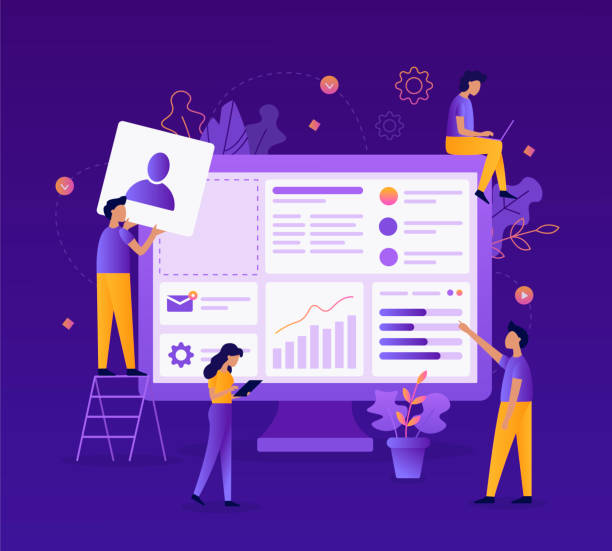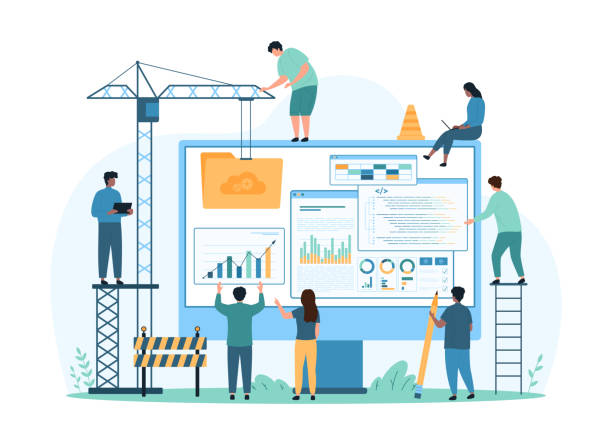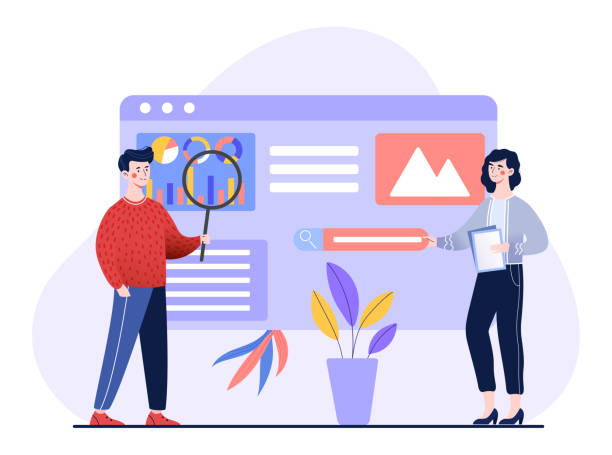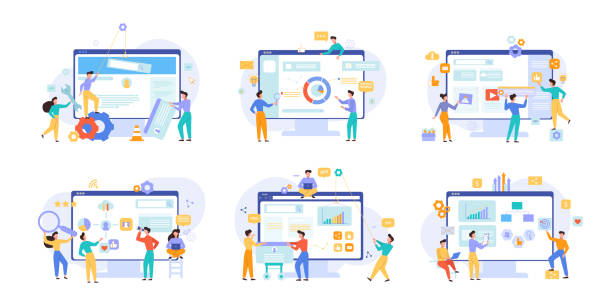The Importance of E-commerce Website Design in the Digital Age

In today’s world, where physical boundaries for commerce have faded, #E_commerce has become the backbone of the new economy.
Having a physical store alone is no longer enough; rather, achieving #Global_Reach and maintaining #Competitiveness in today’s volatile market requires a strong online presence.
An e-commerce website is not only a showcase for your products but also provides a platform for direct interaction with customers, collecting feedback, and analyzing their purchasing behavior.
This explanatory approach allows businesses to access a much wider market with lower costs and keep their operations active 24/7.
E-commerce website design is no longer a luxury option but a strategic necessity for survival and growth in the current digital ecosystem.
This vital step towards digitalization opens up countless possibilities for businesses, including reducing operational costs related to space rental and personnel, as well as enabling access to valuable customer data for personalizing the shopping experience.
In fact, a powerful e-commerce website can quickly strengthen your brand and build customer trust.
The importance of e-commerce website design is such that many traditional businesses are rapidly migrating to the online space to maintain their market share.
This paradigm shift provides unique opportunities not only for large corporations but also for small and medium-sized enterprises (SMEs) to compete globally and deliver their products to customers worldwide.
This becomes especially apparent in situations where physical limitations might hinder normal operations.
Are you tired of your company’s website failing to meet your expectations? With Rasawb, design a professional website that showcases the true face of your business.
✅ Increase acquisition of new customers and sales leads
✅ Enhance your brand’s credibility and trust among the audience
⚡ Get a free website design consultation!
Key Elements of a Successful E-commerce Website

For an e-commerce website design to be truly successful, a set of key elements must be meticulously implemented.
These elements include intuitive #User_Interface and smooth #User_Experience, a strong and reliable #Payment_Security system, high-quality images and detailed product descriptions, and advanced search functionality.
Secure and diverse payment gateways build customer trust and facilitate the purchasing process.
This part of the work is specialized and requires deep knowledge in web design and customer experience.
Furthermore, website page loading speed is of paramount importance; today’s customers have little patience, and a slow website can quickly lead to customer loss.
Responsiveness (Responsive Design) is also crucial, meaning the website must display correctly on all devices, from desktop computers to tablets and smartphones.
Displaying reviews and feedback from previous customers helps new buyers make purchases with more confidence.
A powerful search bar and product filters also allow users to quickly find their desired product.
Ultimately, the e-commerce website design should ensure the payment process is as simple and straightforward as possible to prevent cart abandonment.
Providing adequate post-purchase support is also a key factor in customer retention and building brand loyalty.
Choosing the Right Platform for Your E-commerce Website Design

Choosing the right #Platform for #E_commerce_Website_Design is one of the most crucial decisions to be made at the beginning of the journey.
There are numerous options in the market, each with its own advantages and disadvantages.
Platforms like #WooCommerce (based on WordPress), #Shopify, and #Magento are among the most common choices.
WooCommerce is suitable for small to medium-sized businesses looking for more flexibility and control.
Shopify, with its ease of use and strong support, is suitable for any type of business, while Magento is ideal for large companies with complex needs and high scalability.
This section of the work is educational and helps you make the best decision for the future of your business.
To aid in better decision-making, the following table provides a comparison between these three popular platforms:
| Feature | WooCommerce (WordPress) | Shopify | Magento |
|---|---|---|---|
| Ease of Use | Medium (Requires WordPress knowledge) | High (User-friendly interface) | Low (Requires expert developer) |
| Costs | Low initial, scalability with plugins and hosting | Monthly (various plans), percentage of sales | High (Requires development, strong hosting) |
| Customization | Very High (Open source, many plugins) | Medium (Limited to themes and apps) | Very High (Open source, complex) |
| Scalability | Medium to High (with suitable hosting) | High (Cloud-based) | Very High (for large businesses) |
| Suitable for | Small to medium-sized businesses | All sizes, focus on ease of use | Large and enterprise businesses |
Each of these platforms has its own advantages, and the final choice should be based on your budget, technical knowledge, and long-term business goals.
Before finalizing your choice, it is recommended to conduct thorough research and even consult with several e-commerce website design consultants.
Don’t forget that the future of your website depends on this choice, so don’t rush and make your decision with great care.
Designing Attractive User Experience (UX) and User Interface (UI)

In the competitive world of e-commerce website design, what can set your business apart is the ability to provide an unparalleled #User_Experience (UX) and an attractive #User_Interface (UI).
These two elements not only contribute to the website’s aesthetics but also directly impact conversion rates and customer satisfaction.
Easy #Navigation, #Responsive_Design, and high #Loading_Speed are among the essential components for creating a successful UX/UI.
Responsive design ensures that your website is displayed optimally on any device, from mobile to desktop.
This section of the guide includes attention to minute details.
The goal of e-commerce website design with excellent UX/UI is to provide a simple and enjoyable shopping journey for the customer.
This includes logical product layout, a simple and transparent payment process, and easy access to contact and support information.
Using high-quality images, product videos, and comprehensive, engaging descriptions can enrich the user experience.
Additionally, adding features like wish lists, product comparison, and user reviews helps customers make more informed decisions.
Page loading speed is also crucial; every second of delay can lead to customer loss.
Finally, attention to small details such as fonts, colors, and white space can make a big difference in the visual appeal and ease of use of the website, optimizing the customer experience.
Do you know that your company’s website is the first point of contact for 75% of potential customers?
Your website is the face of your brand. With Rasawb’s corporate website design services, build an online presence that earns customer trust.
✅ Create a professional and lasting image for your brand
✅ Attract target customers and boost online credibility
⚡ Get a free consultation from Rasawb experts!
Search Engine Optimization (SEO) for Online Store

After the completion of your e-commerce website design, the main challenge is to be seen among a multitude of online competitors.
This is where #Search_Engine_Optimization (#SEO) plays its pivotal role.
SEO is a process that helps your website achieve higher rankings in Google and other search engine results and attract more organic (free) traffic.
This involves researching and carefully selecting #Keywords relevant to your products, optimizing website content, and building quality #Link_building.
An e-commerce website without proper SEO is like a beautiful store in the desert.
This section is an analysis of how to increase visibility in search engines.
For SEO optimization, technical aspects must also be considered, such as URL structure, XML sitemaps, and loading speed.
High-quality and relevant content, along with proper use of keywords in product descriptions, page titles, and meta descriptions, is very important.
Additionally, creating a blog or articles section with SEO-focused content relevant to your industry can help attract new audiences and increase your domain authority.
E-commerce website design with an SEO-centric approach from the start can reduce marketing costs in the long run and ensure the sustainability of your business.
Continuous monitoring of competitors and changes in Google’s algorithms is also essential to maintain a top position in search results.
Payment Systems and Data Security

One of the most sensitive and important aspects of e-commerce website design is providing a secure and reliable #Payment_System.
Customers only make online purchases when they are fully confident about the security of their financial and personal information.
Using reputable #Payment_Gateways (such as ZarinPal, Sadad, Mellat) and having a valid #SSL_Certificate are among the first steps in this regard.
An SSL certificate encrypts the communication between the user’s browser and the website server, ensuring that confidential information is not accessible during transmission.
This topic resolves many questionable contents regarding online trust.
In addition to SSL, your website must comply with data security standards such as PCI DSS (for websites that directly process credit card information), although most payment gateways assume this responsibility.
The use of fraud detection systems, strong firewalls, and regular updates of website software are other essential measures in ensuring #Cybersecurity.
Educating website users and personnel about security best practices and avoiding phishing is also highly important.
Ultimately, transparency regarding privacy policies and how user data is utilized significantly helps in building customer trust and loyalty.
E-commerce website design that prioritizes security not only prevents legal risks but also enhances your brand’s credibility.
Marketing and Advertising Strategies for Online Stores

After your e-commerce website design is completed and operational, the next stage is attracting customers and increasing sales.
This is where digital marketing and advertising strategies play a pivotal role.
Using #Content_Marketing, targeted activity on #Social_Media, executing #Email_Marketing campaigns, and employing paid advertising (such as Google Ads) are among the effective approaches.
Each of these channels can attract different audiences and must be optimized according to your product type and target audience.
This is a news section on the latest digital marketing approaches that can ensure your success.
To clarify the picture, the table below compares some of the most important digital marketing channels for an online store:
| Marketing Channel | Description | Advantages | Disadvantages |
|---|---|---|---|
| SEO (Search Engine Optimization) | Optimizing websites for higher rankings in search engines | Organic traffic, sustainable, reduced long-term marketing costs | Time-consuming, competitive, requires continuous updates |
| Pay-Per-Click (PPC) Advertising | Paid advertising on search engines and social media (e.g., Google Ads) | Fast results, targeted, precisely measurable | Costly, requires continuous management and optimization |
| Social Media Marketing | Brand building, customer engagement on platforms like Instagram and Telegram | High engagement, branding, direct customer communication | Time-consuming, requires continuous content creation, algorithm changes |
| Email Marketing | Sending newsletters, offers, and updates to customer email lists | High conversion rate, high personalization, cost-effective | Requires email list, risk of being marked as spam |
| Content Marketing | Producing blog posts, videos, infographics relevant to the industry | Audience attraction, increased credibility and trust, SEO improvement | Time-consuming, requires creativity and expertise |
A comprehensive marketing strategy should include a combination of these channels to achieve the best results.
Data analysis and campaign performance monitoring are also essential for continuous optimization and increasing return on investment.
E-commerce website design is only the first step; smart marketing ensures your long-term success in the online world.
Maintenance, Support, and Scalability of Online Stores
![]()
After launch and marketing, there is another crucial stage in the lifecycle of an e-commerce website: maintenance, support, and scalability.
A successful e-commerce website design requires continuous care to maintain its optimal performance and remain resilient against security threats.
#Updating_operating_systems, plugins, and themes, bug fixing, and monitoring server performance are among the routine maintenance tasks.
Technical support and #Customer_Support are also vital for maintaining user satisfaction.
This section of the explanation includes important tips.
As your business grows, your e-commerce website must also have the capability for #Business_Expansion and respond to higher volumes of traffic and transactions.
This depends on the scalability of your server, database infrastructure, and chosen platform.
Adding new functionalities, integrating with external systems (like CRM or ERP), and continuously improving the user experience are all part of the scalability process.
Planning for regular data backups and having a recovery plan in case of issues is of particular importance.
The sustainability of your e-commerce website design hinges on these proactive and reactive measures.
Ignoring these aspects can lead to serious website performance issues, data loss, and ultimately, customer loss.
Therefore, investing in maintenance and scalability is an investment in the future of your business.
Are you disappointed with your online store’s low conversion rate?
Rasawb, with its professional e-commerce website design, is your definitive solution!
✅ Increase your sales and revenue
✅ Unparalleled user experience for your customers
⚡ Get a free consultation right now!
Common Mistakes in E-commerce Website Design and Ways to Avoid Them

In the course of #E_commerce_Website_Design, businesses may make mistakes that can harm their success.
Among the most common mistakes are #Lack_of_Responsive_Design (not mobile-friendly), #Poor_User_Experience and complex payment processes, inattention to #Low_Security, and inappropriate product display.
Ignoring customer reviews and feedback can also eliminate opportunities for improvement.
Identifying and avoiding these mistakes can make a big difference in conversion rates and customer satisfaction.
This content can be entertaining for you, as it offers lessons from the experiences of others.
Another common mistake is not optimizing the website for loading speed, which leads to early user abandonment.
Using large images, messy code, and weak servers are factors that reduce speed.
Additionally, providing insufficient or misleading product descriptions, the absence of a Frequently Asked Questions (FAQ) section, and the lack of a transparent return policy can lead to customer distrust.
E-commerce website design should be such that the customer feels in complete control of the purchasing process.
Forgetting post-sales customer support and neglecting the importance of SEO from the outset are also among the costly errors.
To avoid these, meticulous planning, conducting usability tests, and continuously updating the website based on user feedback and data analysis are essential.
Learning from others’ mistakes is a sure path to success for your e-commerce website.
The Future of E-commerce Website Design and Emerging Trends

The world of e-commerce website design is constantly evolving, with emerging trends shaping the future of e-commerce.
#Artificial_Intelligence (AI), #Augmented_Reality (AR), and extreme #Personalization are among the technologies that will revolutionize the online shopping experience.
AI can provide much more accurate and personalized product recommendations, while augmented reality allows customers to view products in their real-world environment before purchase.
Voice search and advanced chatbots will also become an integral part of e-commerce websites.
This section is an exciting news piece about a future where e-commerce websites will become increasingly smart and interactive.
Other trends such as contactless payments, blockchain for increased transparency and security, and sustainability in e-commerce are also emerging.
Personalization, through user data analysis, allows businesses to create a unique shopping experience for each customer.
Sustainability and corporate social responsibility have also become important factors in customers’ purchasing decisions, so e-commerce website design must reflect these values.
No-code/low-code platforms also make e-commerce website design more accessible for non-technical individuals and help democratize e-commerce.
For future success, businesses must carefully monitor these trends and plan their strategies to integrate these technologies into their e-commerce website design.
Frequently Asked Questions
| Question | Answer |
|---|---|
| What is e-commerce website design? | E-commerce website design refers to the process of building and developing an online platform that allows users to purchase products or services online. This includes user interface design, user experience, security, shopping cart, and payment gateway. |
| Why is having an e-commerce website important for businesses? | Having an e-commerce website allows businesses to be active 24/7, expand their target market, reduce operational costs, and provide easier access for customers to their products. |
| What are the most important features of a successful e-commerce website? | The most important features include excellent User Interface and User Experience (UI/UX), high loading speed, security (SSL and secure payment gateway), Responsive Design, Search Engine Optimization (SEO), and easy management of products and orders. |
| What is the role of SEO in e-commerce website design? | SEO helps your e-commerce website achieve higher rankings in Google and other search engine results. This leads to an increase in organic visitors and, ultimately, an increase in sales. |
| What is the importance of security in e-commerce websites? | Security is crucial for protecting sensitive customer information (such as banking and personal data). Using an SSL certificate, secure payment gateways, and adhering to security standards build customer trust and prevent fraud. |
| What are the common platforms for e-commerce website design? | Common platforms include WooCommerce (for WordPress), Shopify, Magento, PrestaShop, and also custom development, each with its own advantages and disadvantages. |
| What does Responsive Design mean for an e-commerce website? | Responsive design means that your e-commerce website displays correctly and optimally on any device (mobile, tablet, laptop). This is very important for user experience and SEO. |
| How can user experience (UX) be improved on an e-commerce website? | User experience can be improved by simplifying the purchasing process, easy navigation, attractive visual design, providing complete product information, customer reviews, and online support. |
| What is the role of product images and descriptions on an e-commerce website? | High-quality images and complete, detailed product descriptions help customers make better decisions and trust the product. This directly impacts the Conversion Rate. |
| What is the importance of customer support on e-commerce websites? | Strong and prompt customer support increases customer satisfaction and loyalty. Providing various support channels (phone, online chat, email) and responding to questions and resolving issues boosts the store’s credibility. |
And other services of Rasa Web Advertising Agency in the field of advertising:
Smart Content Strategy: A combination of creativity and technology to increase website traffic through Google Ads management.
Smart Link Building: An innovative platform to improve click-through rates with Google Ads management.
Smart Custom Software: Designed for businesses seeking to analyze customer behavior through optimizing key pages.
Smart Direct Marketing: Designed for businesses looking for online growth through attractive UI design.
Smart Digital Advertising: A novel service to increase website traffic through precise audience targeting.
And over hundreds of other services in the field of internet advertising, advertising consulting, and organizational solutions.
Internet Advertising | Advertising Strategy | Advertorial
Resources
Comprehensive Guide to E-commerce Website Design at NamatekKey Tips for Successful Online Store Design at WebramzReview of Advanced Online Store Design Platforms at Iran HostCost of Advanced E-commerce Website Design at Naghshe Almas
?At Rasawb Afarin Digital Marketing Agency, we help your business shine brightly in the online world. From secure website design to comprehensive SEO strategies and targeted content creation, we are your trusted partner on the path to digital growth.
📍 Tehran, Mirdamad Street, Next to Central Bank, Kazeroun Jonoubi Alley, Ramin Alley, No. 6


